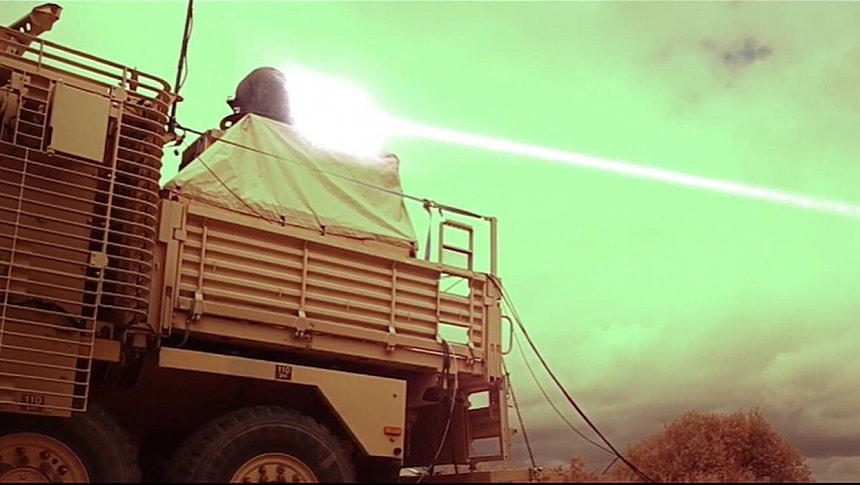In the span of just two years, which is how long it's been since Russia's full invasion of Ukraine has begun, drones have become game-changers on the battlefield. And I'm not talking about the strategic, heavy ones, but about the flying contraptions that are small and nimble enough to wreak havoc among enemies.
The prevalence of drones on the battlefield and their effectiveness have prompted defense contractors to come up with increasingly innovative – and at some level even sci-fi-like – anti-drone solutions. Like, say, lasers.
One such system currently in operation is something called the High-Energy Laser Weapon System (HELWS), made by American company Raytheon. It's a tech that's already deployed in the service of the American armed forces, and it has already scored more than 400 drone kills during some 40,000 hours of testing, and probably during military operations as well.
The British Army is interested in adopting the American laser as well, and to do that it runs a program called Land Laser Directed Energy Weapon (LDEW) Demonstrator. And the effort just scored a major win as HELWS was put to use on an armored truck called Wolfhound.
It was for the first time in the history of the country that a laser weapon was integrated into and fired from a land vehicle.
The Wolfhound is the six-wheel version of the Mastiff armored truck. Together with two other versions, the Husky and the Coyote, it is used to perform frontline patrols and transport supply and ammunition. Normally, the truck carries a 7.62 GPMG machine gun.
The HELWS deployed on this particular truck was purpose-made to defeat NATO class 1 drones, meaning the ones that are flying in the 33-pound (15 kg) category and can reach altitudes of as much as 5,000 feet (1,500 meters).
The laser is portable, meaning it can be moved closer to the action, or further away, as the case may be, and can be integrated with pretty much all air defense systems in existence, but also with radars and command and control systems.
Raytheon makes two versions of the laser, one with a power of 15 kW (meant for class 1 and 2 drones) and the other much larger, at 50 kW (made to counter class 3 drones).
Both can track targets in open sky and in ground clutter, and have unspecified, but certainly beyond visual range. The lasers are battery-powered and can be kept operational for about eight hours at a time.
The British test was conducted at the Dstl's range in Porton Down and saw the system being fired at full power. The Army plans to truly adopt HELWS, so it will continue testing the laser in a bid to "allow British Army soldiers to familiarise themselves with the system and refine requirements for future capability."
One such system currently in operation is something called the High-Energy Laser Weapon System (HELWS), made by American company Raytheon. It's a tech that's already deployed in the service of the American armed forces, and it has already scored more than 400 drone kills during some 40,000 hours of testing, and probably during military operations as well.
The British Army is interested in adopting the American laser as well, and to do that it runs a program called Land Laser Directed Energy Weapon (LDEW) Demonstrator. And the effort just scored a major win as HELWS was put to use on an armored truck called Wolfhound.
It was for the first time in the history of the country that a laser weapon was integrated into and fired from a land vehicle.
The Wolfhound is the six-wheel version of the Mastiff armored truck. Together with two other versions, the Husky and the Coyote, it is used to perform frontline patrols and transport supply and ammunition. Normally, the truck carries a 7.62 GPMG machine gun.
The HELWS deployed on this particular truck was purpose-made to defeat NATO class 1 drones, meaning the ones that are flying in the 33-pound (15 kg) category and can reach altitudes of as much as 5,000 feet (1,500 meters).
The laser is portable, meaning it can be moved closer to the action, or further away, as the case may be, and can be integrated with pretty much all air defense systems in existence, but also with radars and command and control systems.
Raytheon makes two versions of the laser, one with a power of 15 kW (meant for class 1 and 2 drones) and the other much larger, at 50 kW (made to counter class 3 drones).
Both can track targets in open sky and in ground clutter, and have unspecified, but certainly beyond visual range. The lasers are battery-powered and can be kept operational for about eight hours at a time.
The British test was conducted at the Dstl's range in Porton Down and saw the system being fired at full power. The Army plans to truly adopt HELWS, so it will continue testing the laser in a bid to "allow British Army soldiers to familiarise themselves with the system and refine requirements for future capability."









